Abstract
Natural fiber-reinforced composites can contribute to reducing carbon footprint goals due to their ability to reduce overall product weight, bio-diverse feedstocks, and recyclability potential. In this work, natural fiber-based composites containing the reinforcement of coconut husk and bagasse fiber with calcium carbonate (CaCO3) ingredients were prepared and analyzed. The composites were analyzed for mechanical, thermomechanical, and morphological properties. The reinforcements were chemically functionalized using 5% w/v NaOH to enhance their interactions with the epoxy resins. The chemical functionalization created perforation on the fiber surface, improving the interlocking of fibres with the resin material and strengthening the mechanical performance of the composite. The composites developed using modified reinforcement treatment resulted in increased tensile strength (64.8%) and flexural strength (70%). The reinforcement treatment influenced the hydrophilicity, and the water absorption of treated composites was reduced more than five times compared to the unmodified composites. Scanning electron microscopy revealed morphological changes due to fiber modification, the underlaying mechanism of fiber contraction, and enhanced fiber matrix interface interlocking and adhesion strengthening. Thermal analysis confirmed that alkali treatment improves the crystallinity of the fiber and thereto the degradation temperature of treated fiber composites (both bagasse and coconut husk), which is 375.27 °C, the highest amongst the developed hybrid composites.
1. Introduction
Environmental concerns and increasing demand for lightweight structures by the automotive industries have encouraged these industries to adopt sustainable composites, particularly natural fiber reinforcements in polymer composites, for making vehicles. Natural fibers are effectively used to develop composite material, which shows excellent strength (in some applications) compared to synthetic fibers. Bagasse is a waste product and can be obtained by extracting the juice from sugarcane. Bagasse is frequently used as a combustible material in the sugarcane industries for energy supply. It has other applications, such as being used as pulp in paper industries and for developing fiber-board. It has been shown that the fiber composites’ strength primarily depends on interfacial adhesion and the transfer of stress from the matrix to the fiber. The stress transfer phenomenon played a significant role in evaluating the mechanical properties of fiber-reinforced composites [1].
Coconut is generally found in humid tropical regions. It is used as an oil, fruit, etc., and is primarily found in Africa, Latin America, and Southeast Asia [2]. Coconut husk can be used to produce coir fibers [3]. The approximate primary composition of coconut husk is “cellulose 40%”, “hemicellulose 20%”, and “lignin 30%” [4]. Most of the present research lacks the effective utilization of coconut husk as a functional material [5].
As per the Brazilian Institute of Statistics, the production of Brazilian coconut in 2017 was around 1.7 million tons, which generated coconut fiber as a waste. According to previous studies, coconut fiber could have various applications in building materials, as it has tremendous physical, thermal, and mechanical properties [http://www.abc.gov.br/training/informacoes/InstituicaoIBGE_en.aspx] (accessed on 30 November 2022). The most significant component of coconut fiber is tannin, a natural fungicide that prevents fungal and insect attacks [6].
The only problem with regard to the mechanics of fiber reinforcement is their hydrophilic nature. Because of this hydrophilic nature, proper interfacial strength is not achieved and this negatively affected the mechanical properties of the composite material. Interfacial adhesion is a significant factor in deciding the adhesion ability between the “fiber” and the “matrix”. The reason behind the deficient bonding is the moisture availability in the fibers. Pendant hydroxyl groups and polar groups are responsible for the moisture. So, to efficiently utilize fiber reinforcements in composites, one must perform fiber surface treatment to get a better interlock or adhesion with the matrix.
To enhance the mechanical properties, one needs to treat the natural fibers to make them hydrophobic. There are two types of treatments available. One is a physical treatment, and the other is a chemical treatment, which ultimately makes the fiber surface rough, removes the moisture from the fiber surface, and improves the adhesion strength with the matrix. On the other hand, bleaching strengthens the alkalized fibers by improving the fiber’s surface energy and crystallinity [7].
In the case of a hydrophobic polymer matrix, natural fiber reinforcements are challenging because of their high polarity. This is because of the high polysaccharide content, which affects the bondability between the fiber and the matrix [8]. Chemical treatment showed a positive effect, specifically the interaction of the “fiber and polymer matrix”, “adsorbent and adsorbate”, “enzyme and support”, and “functionalizing agent and support” [9].
The disruption of hydrogen bonding removes polysaccharides and impurities from the fiber surface, such as hemicellulose, lignin, pectin, wax, and oils. It makes them rough by reducing their hydrophilic nature and is the primary goal of alkali treatment [10].
Alkalization significantly improves the fibers’ mechanical properties. Different parameters, including fiber length, loading, and orientation, were analyzed in developing the polypropylene/sisal composites. It is observed that a fiber length of 2 mm gives optimum and good results [11].
So, alkalization ultimately improves the adhesion ability or interfacial bonding strength, leading to improved mechanical properties [12,13].
Bagasse fiber and coconut shell particles reinforced cardanol composites show high mechanical properties. Raw bagasse fibers and coconut shell particles are hydrophilic in nature, ultimately affecting the composites’ mechanical properties. However, alkalized bagasse and coconut shell particles showed excellent mechanical properties [14].
The chemical concentration, processing time, and temperature are the significant factors that must be considered before the mercerization/alkalization of the natural fibers [15].
However, the Bagasse mainly fuels sugarcane mill furnaces despite its low caloric power. So, its reinforcement into the polymer is a good solution for boosting the problems of bagasse fiber disposal [16]. Figure 1 shows raw (untreated) bagasse fiber and coconut husk.
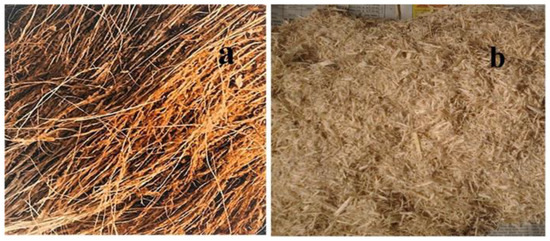
Figure 1.
(a) Raw Coconut husk (b) Raw bagasse fiber.
It has been observed that two significant factors, entangle inclination and fiber agglomeration, occur during the processing of the polymer composites. This is just because of the fiber–fiber interactions. Alkalization is a suitable surface treatment method to overcome this problem [17]. Mercerization ultimately improves the fibers’ surface properties, which is useful in fiber-matrix bonding [18].
Umit and co-workers have performed different treatments on flax fibers, such as acetic acid, sodium hydroxide, and silane. They found that NaOH (alkalization) is a suitable treatment that enhances the adhesion strength between the fibers and the matrix with enhanced mechanical properties [19].
Alkali-treated bagasse and green coconut fibers were utilized for particle board production with two distinct densities, i.e., 500 and 700 kg/m3. The particleboards consist of three layers: one layer of bagasse fiber and two layers of green coconut fibers. The boards were bonded with castor oil-PU resin. Fatigue results showed that all the developed particle boards are able to survive 40,000 cycles at a 25% stress level of the fracture load [6].
PLA-based natural rubber and alkalized bagasse fiber-reinforced composite foams were developed. It has been found that composite foams showed distinct improved mechanical properties of treated bagasse fibers than the untreated ones [20].
Two types of polypropylene-based composites have been developed using alkalized bagasse fiber and raw bagasse fibers with calcium carbonate (CaCO3). It has been observed that alkalized bagasse fiber-CaCO3 composites showed excellent mechanical properties compared to the raw bagasse-CaCO3 hybrid composite. In addition, good thermal properties of the alkalized bagasse fiber-CaCO3 composite were observed, as confirmed by the thermogravimetric analysis and derivative thermogravimetric analysis [16].
Green bagasse fibers were alkalized with 5% NaOH and used for developing polyester resin-based composites. The treated bagasse fiber exhibited improved mechanical properties compared to the untreated ones. In addition, water absorption and chemical resistance tests showed favorable results concerning their applications [21].
Two distinct types of epoxy-based composites were developed by using raw coconut sheaths and alkalized (5 wt%) coconut sheaths. It was noticed that the treated coconut sheath-epoxy composites showed excellent mechanical properties compared to the raw coconut sheath-epoxy composites. In addition, treated coconut sheath-epoxy composites showed good thermal stability and storage modulus, as confirmed by TGA and DMA analysis [22].
The reinforcement of CaCO3 ultimately improved the mechanical properties; precisely, the composites’ compression strength, flexural strength, and impact strength. In addition, the higher melting point of the CaCO3 showed better thermal stability, as confirmed by TGA analysis [23].
The present investigation used bagasse fibers, coconut husks (chemically modified/unmodified), and CaCO3 to develop hybrid composites. The hybrid reinforcement is expected to improve the epoxy composites’ mechanical properties and thermal stability. In the present research, the effect of the inclusion of alkalized and non-alkalized fibers with the nano reinforcement, i.e., CaCO3, on the mechanical and thermal properties of the composites was observed, and their comparative analysis was established. Various mechanical properties, including tensile, compression, and flexural properties, were evaluated and reported. Water absorption tests were also performed to investigate the water uptake behavior of the developed composites. Thermal analysis was performed using TGA analysis.
2. Materials and Methods
2.1. Materials
Epoxy resin (CY230), hardener (HY951), and acetic acid were supplied by SDC Ltd., New Delhi, India. The DSM, India, provided the bagasse fibers, and coconut husk was collected from the local market. CaCO3 was supplied by RFCL Limited, Noida, India. The average compositions of bagasse fiber and coconut husk are shown in Table 1 and Table 2 [24,25,26], respectively.

Table 1.
Average bagasse composition [26].

Table 2.
Average Coconut husk composition [25].
2.2. Chemical Treatment of Fibers
Firstly, the fibers were washed with hot water to remove dirt and dried in an oven overnight. The oven-dried fibers were treated with “5% (wt./v) NaOH solution” at room temperature for two hours. Distilled water was used to remove alkali traces, followed by neutralization with 1 wt% acetic acid solution. The alkalized fibers were then again oven-dried to remove any moisture [27,28].
2.3. Development of Composite
For developing a hybrid composite material, bagasse fiber and coconut husk were mixed at a constant weight percentage, i.e., 10 wt% (chemically modified and unmodified), and 4 wt% of CaCO3. The four classes of hybrid composites, i.e., C1, C2, C3, and C4, were developed using alkalized and native fibers, i.e., bagasse fiber and coconut husks. The C1 composite consists of both untreated fibers with calcium carbonate; the C2 composite has both alkalized (modified) fibers with calcium carbonate; the C3 composite consists of unmodified bagasse, modified coconut husk, and calcium carbonate; C4 composite comprised modified bagasse fiber and unmodified coconut husk with calcium carbonate.
The bagasse fiber, coconut husk, and CaCO3 mixture was heated at a temperature of 90 ± 10 °C for two hours in the furnace and remixed at each interval of 30 min by a mechanical stirrer. After two hours, the mixture was allowed to cool until 45 °C, followed by mixing of the hardener HY951 (8 wt%) at the same temperature [29]. A mechanical stirrer was used to remix the mixture. The samples were prepared by using the hand lay-up method. The nomenclatures of all the composites are exhibited in Table 3. Figure 2 exhibits the different developed composite samples.

Table 3.
Classification/nomenclature of the developed composites.
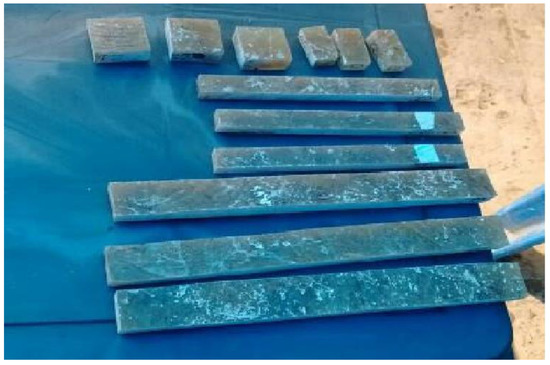
Figure 2.
Different developed composites samples.
2.4. Characterizations
ASTM D3039 standard was followed for evaluating the tensile properties of the developed composites. The specimens’ dimension for the analysis was 100 × 10 × 5 mm. A universal testing machine (UTM, Instron model eXpert 2600 Dual Column Testing Machine, ADMET, Norwood, MA, USA) at 0.5 mm/min crosshead speed and 50 mm gauge length was used for tensile strength evaluation (Figure 3).
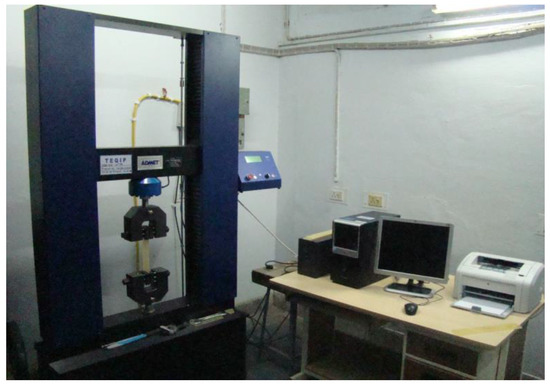
Figure 3.
ADMET Universal Testing Machine (UTM, Instron model eXpert 2600 Dual Column Testing Machine, Norwood, MA, USA).
UTM determined the compressive properties at 0.5 mm/min crosshead speed by following the ASTM D 3410 method. The dimension of the samples was 143 × 12.7 × 3.18 mm.
The flexural properties were evaluated by following the ASTM D 790 method. The sample dimension was 125 mm × 12.5 mm × 3.2 mm.
Water absorption evaluation was performed according to the ASTM D570-98. The dimension of the specimen was 120 × 75 × 3 mm. For water absorption studies, the specimens were dried at 110 °C using the oven for one hour and weighed after cooling to check and confirm the absorbed water’s effect. In the next step, the specimens were immersed in “distilled water” at room temperature and then weighed. The water gain percentage, water absorption (%), was evaluated by Equation (1):
where W represents the final weight after water absorption and Wd is the dry specimen weight. A clean tissue paper is used to wipe out the excess surface water of the samples and left in the ambient environment for about 2 min [30].
Water absorption = [(W − Wd)/Wd] × 100
Thermogravimetric analysis (TGA and DTA) was performed using model SII 6300 EXSTAR, made by Exstar Asia (Bangkok, Thailand). The degradation of the composites was evaluated at a constant scan rate of 10 °C/min. The temperature range was selected from ambient temperature to 1000 °C under an N2 atmosphere.
Scanning electron microscopic examination was performed by LEO435V6, India (Carl Zeiss, Jena, Germany). The square specimens were prepared (10 × 10 mm) for the analysis. The silver-coated samples were then placed inside a chamber and an electron beam was fallen on the material. The accelerated voltage was kept at 20 kV. Various images were captured at different magnification levels.
3. Results
3.1. Water Absorption
Water absorption through the model can be understood by three different mechanisms, (a) moisture content diffusion into the micro voids between the polymer chains, (b) capillary transportation of the moisture through these micro voids, and (c) availability of various flaws between the fiber and the matrix interfaces. It has been seen that the absorption of the moisture is primarily through the interface between the fiber and the matrix and also by the fiber through the hydrogen bonding. Figure 4 shows the water absorption graphs of different samples. The results showed that in the initial hours, the water absorption % of the C2 & C3 is comparatively low compared to the other developed composites. C1 composite shows more water absorption than the other developed composites. This is because both fibers were untreated and have hydrophilic properties. On the other hand, the C2 composite showed much less water absorption behavior because of the treated fibers. Fiber treatment removes the cellulosic contents from the fiber surface, making them almost hydrophobic [13,28].
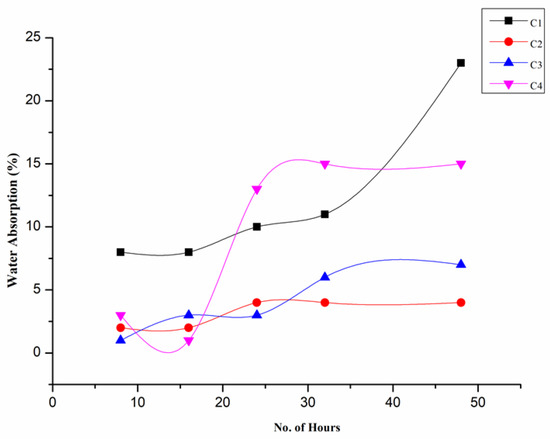
Figure 4.
Water absorption (%) values of developed composites.
3.2. Tensile Strength
Table 4 shows the tensile properties of the developed composites. Remarkable differences can be noticed in the ultimate stress of the composites with distinct compositions.

Table 4.
Tensile properties of the composite with different treatments.
From Table 4, it is observed that the C1 composite shows a tensile strength of 18.8 MPa. However, the tensile strength value of the C2 composite is 31 MPa. It means that it is improved by 71.96%. The reason for the increased tensile strength is that, in the C1 composite, both fibers, i.e., coconut husk and bagasse fiber, were untreated. This is because the fibers consist of hemicellulose, pectin, lignin, and waxy content, resulting in poor adhesion ability with the matrix [22]. However, in the case of the C2 composite, both fibers were chemically treated with NaOH, which removes hemicellulose, pectin, lignin, and waxy content from the fibers and makes their surface rough, and improves adhesion ability [14,31]. The tensile strength of the C3 composite is 25.6 MPa. If we compare this value from the C1 composite, there will be an increase in tensile strength by 42.22%. This is because the C1 composite is reinforced with untreated fibers. However, the C3 composite is reinforced with the chemically treated coconut husk. In addition, the tensile strength value of the C4 composite is 19.46 MPa, which is 8.11% higher than the C1 composite but reduced by 23.98% as compared to the C3 composite. This is because of the excessive contiguity within the calcium carbonate particles, resulting in increased disturbance of bonding between molecular chains. The tensile strength is reduced because of the non-uniform dispersion of nanoparticles and accumulation of the fibers, leading to deficient fracture resistance because of the development of a large number of tiny cracks. Agglomeration generates defects on the material surface, resulting in a stress concentration. The fiber agglomeration also poses weak interaction or adhesion strength between the fiber and the matrix, resulting in the deterioration of the tensile strength [32]. Figure 5 shows the tensile stress strain curves of different developed composites.
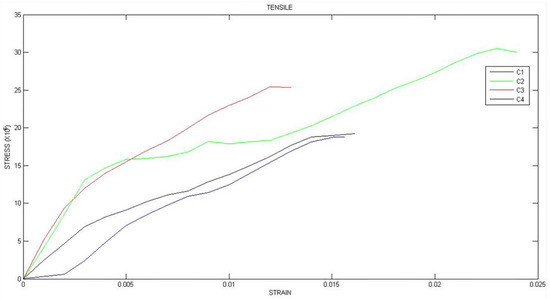
Figure 5.
Tensile stress-strain curves of the developed composites.
3.3. Compression Strength
The compressive properties for composites C1, C2, C3, and C4 are shown in Table 5 for the ultimate compression strength, and the ratio of ultimate compressive strength to ultimate tensile strength values at 0.5 mm/min strain rate.

Table 5.
Compressive properties. Values of the ratio of ultimate compression strength to ultimate tensile strength of bagasse fiber, coconut husk, and CaCO3 composites.
Table 5 shows that the compression strength of the C1 composite is 34 MPa; however, for the C2 composite, it is improved by 169.20% compared to the C1 composite. Similar trends were also observed for the C3 composite. The compression strength value of the C3 composite increased by 91.17% (compared to the C1 composite) and was found to be 65 MPa. In addition, for the C4 composite, it is increased by 30.885% (compared to C1 Composite) and was found to be 44.5 MPa.
The literature confirmed that the reinforcement of CaCO3 (4% wt./wt.) gives good compression strength. In compression, failure of the specimen is mainly attributed to the micro-buckling of the fibers in shear, which increases the compressive properties of the material [33]. The improvement in the compression strength of the composite may be because of the chemically treated fibers, showing a possible enhancement in the fiber-matrix interfacial bond [34].
3.4. Flexural Strength
Table 6 exhibits the values of flexural modulus and flexural strength of the developed composites.

Table 6.
Flexural modulus and flexural strength of bagasse fiber, coconut husk, and CaCO3 composites.
From Table 6, the flexural strength of the C1 composite is 37.16 MPa. On the other hand, the C2 composite is 63.39 MPa, which is increased by 71.39%. Similarly, for C3 composites, the flexural strength increased by 42.14% (compared to the C1 composite) and was found to be 52.82 MPa. In addition, for the C4 composite (in comparison with the C1 composite), the flexural strength increased by 30.86% and is 48.63 MPa. Conversely, the C2 composite showed higher flexural stress than the other developed composites. The lowest value can be observed in the C1 composite, which consists of both untreated fibers. So, the conclusion can be made that mechanical properties were increased by performing the chemical treatment of the fibers [35].
The reason for the increased flexural strength resides with the chemical treatment of fibers [21]. Modifying the surface of the natural cellulosic fibers increases the fibers’ hydrophobicity and enhances the polymer matrix’s adhesion [22]. So, the natural fiber surface treatment enhanced the hydrophobic character and decreased the fibers’ hydrophilicity [32]. The nanoparticle reinforcement (CaCO3) also improves the “contact surface area of the matrix”, enhancing the matrix-filler stress transfer and improving their strength [36,37].
The stiffness of the matrix increased by the inclusion of the nanoparticles. Reinforcement of filler content increases the modulus due to the contribution of the hard particles [37,38].
3.5. Thermogravimetric Analysis
All alkali-treated composites (C2, C3, C4) showed good thermal stabilities compared to the untreated composite (C1). Figure 6a,b show TGA and DTA graphs of the developed composites. Three stages were observed during the thermal degradation process. In the first stage, decomposition occurs because of moisture and other volatile matter [16]. This phase occurs above 120 °C [23]. On further increased in the temperature, this resulted in the second stage of degradation. The second stage was predominated by cellulose decomposition [39,40]. The third stage was predominated by the lignin decomposition.
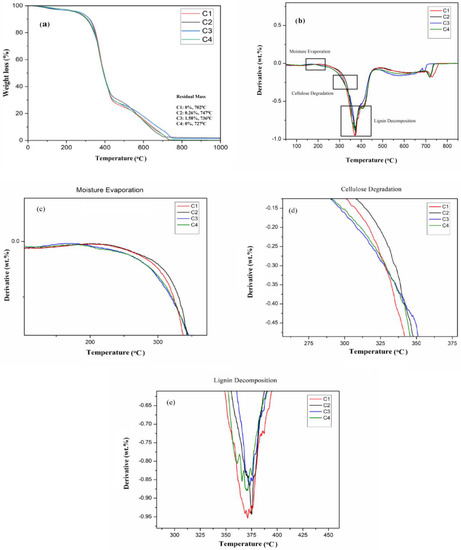
Figure 6.
(a) TGA curves of developed composites (b) DTG curves of composites, (c) Moisture Evaporation, (d) Cellulose Degradation, and (e) Lignin Decomposition.
From Figure 6a, the decomposition of hemicellulose occurs within the temperature range of 200 to 300 °C. Next is the cellulose decomposition within 450 °C.
All the composites have calcium carbonate as a filler showing a melting point of around 800 °C [41]. This can be evidenced by the current results, as most of the developed composites degraded at this temperature. Hence, in the third stage, i.e., from 450–800 °C, all the constituents of the composites are carbonized and decomposed. The figure also confirmed that all the developed composites show the same thermal degradation trend, but C1 composites decompose earlier than the C2, C3, and C4 composites. This is because the C1 composite consists of both (coconut husk and bagasse fiber) unmodified/untreated fibers with CaCO3 and higher hydrophilicity and amorphous contents of bagasse fiber and coconut husk in their unmodified form. Other composites (C2, C3, and C4) show almost similar thermal behavior because at least one fiber (Bagasse or Coconut husk) is in the modified form in the composites. Modification ultimately improves the crystallinity of the fiber.
Figure 6b shows that the C2 composite (both fiber alkalized) showed higher degradation temperature than all developed composites. In addition, C1 has the lowest thermal degradation of the other developed composites because it is composed of untreated fibers [16]. The comparison can be made based on the C1 composite, as all the developed composites show almost the same temperature values. Because the C1 composite consists of both untreated fibers, it shows a lower degradation temperature. From Figure 6b, the C1 composite shows a temperature value of 370.95 °C. However, the C2, C3, and C4 composites show temperature values of 375.27 °C, 372.21 °C, and 371.25 °C, respectively. Figure 6c–e shows the zoomed-in images of the different processes such as moisture evaporation, cellulose degradation, and lignin decomposition during the thermal analysis for a better understanding.
3.6. Microstructure
A scanning electron microscope was used to investigate the microstructure of the developed composites. Figure 7 shows the SEM images of bagasse fiber and coconut husk before and after alkali treatment (5% w/v). Figure 7a,c show the SEM images of untreated bagasse fiber and coconut husk. A rough surface of the fibers is observed because of the various waxy elements such as fatty tissues, hemicellulose structure, and sugarcane lignin on the fiber’s surfaces. On the other hand, Figure 7b,d exhibit the treated/alkalized bagasse fiber and coconut husk. Figure 7b,d clearly show that after alkalization, the impurities, waxy layers, and hemicellulose structure are removed. A highly fibrillated surface with reduced diameter and increased surface area is observed [42].
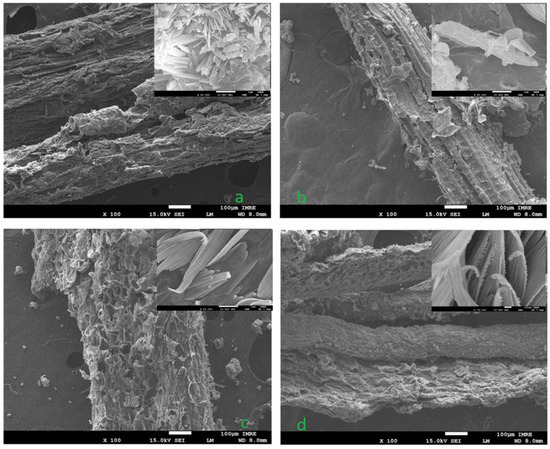
Figure 7.
Figure 7. (a) Untreated bagasse fiber, (b) treated (alkalized) bagasse fiber, (c) untreated coconut husk, (d) treated (alkalized) coconut husk.
Figure 8a shows the SEM image of the C1 composite, which consists of untreated/unmodified bagasse fiber, coconut husk, and CaCO3. CaCO3 is uniformly distributed in the matrix [43], as confirmed by the figure. Some micro-voids are observed in the image. This is because the untreated fibers result in poor adhesion ability with the matrix. The average diameter of bagasse fiber is 16.23 μm [44], and coconut husk is 10.4 μm (https://www.fao.org/economic/futurefibres/fibres/coir/en/ accessed on 30 November 2022). Figure 8b shows the SEM image of both (bagasse and coconut husk) alkali-treated fibers. The figure shows that the fiber diameters are significantly reduced after alkalization. The average diameter of bagasse fiber after alkali treatment is 11.5 μm, much less than the untreated bagasse fiber. In addition, the diameter of coconut husk fibers reduced to 5.2 μm from 10.4 μm. This is attributed to alkalization, which removes the cellulose and wax from the surface of the fibers and makes them rough. Additionally, good interfacial bonding can be observed, leading to improved composite mechanical properties, as evidenced by the results.
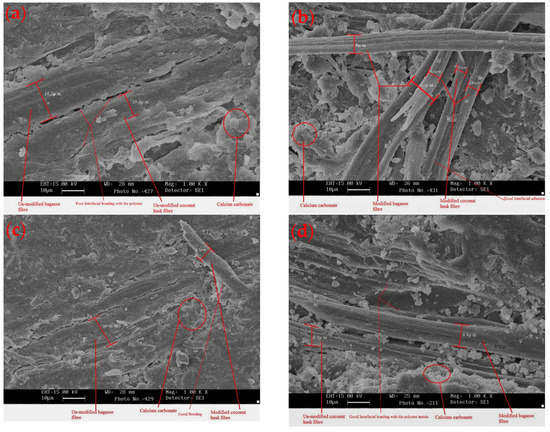
Figure 8.
SEM images of (a) C1 composite (b) C2 composite (c) C3 composite (d) C4 composite.
Similarly, Figure 8c shows the morphology of the C3 composite (chemically-treated coconut husk and untreated bagasse with CaCO3). The untreated bagasse shows an average fiber diameter of around 14.4 μm, while the treated coconut husk shows an average fiber diameter of 6.1 μm. A few microvoids can be observed in the figure. Figure 8d shows the morphology of the C4 composite (untreated coconut husk and treated bagasse fiber with CaCO3). Similar trends were observed in the figure. The average fiber diameter of the untreated coconut fiber is 9.5 μm, while the treated bagasse fibers have an average diameter of 9.4 μm. Uniform dispersion of the calcium carbonate can be observed from the figure with fewer voids. It has been confirmed from the mechanical properties of all developed composites that all composites with both or single fiber treatment (C2, C3, C4) showed excellent mechanical properties compared to the untreated ones (C1).
So, a noticeable effect on mechanical properties is observed in all developed composites because of the uniform dispersion of fibers and CaCO3 in the matrix.
4. Conclusions
Novel hybrid composite materials have been developed by exploiting natural fibers and calcium carbonate. The conclusions from this study are as follows:
- The water absorption capacity of the composite with both unmodified fibers was found to be the highest among all the developed composites. The water absorption capacity of the composites decreases in the case of treated fiber composites and is found to be the least in the C2 composite (having both fibers chemically treated). The water absorption capacity of the C4 composite with modified bagasse fiber and unmodified coconut husk fiber was higher than that of the C3 composite with modified coconut husk fiber and unmodified bagasse fiber.
- The ultimate tensile strength of the C1 composite with both unmodified fibers was the least among the developed composites. Modifying the fibers shows adequate bonding between the “fibers and the matrix”. The ultimate tensile strength of the composites with both modified fibers (C2) was the highest among the developed composites. The C3 composite with modified coconut husk fiber and unmodified bagasse fiber was higher than the C4 composite with modified bagasse fiber and unmodified coconut husk fiber.
The yield strength of the composites also followed the same pattern as the ultimate tensile strength.
- The compressive strength of the composites increased by modifying the fibers. In addition, the yield strength of all developed composites followed the same pattern, while the elastic modulus of the C3 composite with modified coconut husk and un-modified bagasse fiber was found to be the highest amongst all the composites. The C1 composite, with both unmodified fibers, was found to have the least elastic modules among all the developed composites.
- The flexural strength of the C1 composite (both untreated bagasse and coconut husk) was found to be the least among all the developed composites. The flexural strength of the composites tends to increase with chemically modified fibers. The C2 composite with both modified fibers was found to be highest amongst all the developed composites, followed by the C3 composite with modified coconut husk and un-modified bagasse fiber. The flexural strength of the composite C4 was higher than C1 but lower than C2 and C3.
- Thermal studies showed that all the developed composites have good thermal stabilities, but the modified/alkali-treated composites show better thermal stability than the untreated/unmodified ones.
Thus, the surface modification treatment could enhance the interfacial adhesion between the fibers and matrix. Consequently, this resulted in increased mechanical and thermal properties of the composites.
Author Contributions
Investigation and writing, D.V.; formal analysis, M.O.; review and suggestions, M.S., K.L.G. and M.O. All authors have read and agreed to the published version of the manuscript.
Funding
This research received no external funding.
Institutional Review Board Statement
Not applicable.
Informed Consent Statement
Not applicable.
Data Availability Statement
No new data were created.
Acknowledgments
Authors are thankful to the Inter-Department of Nanoscience and Technology, Graduate School, Chulalongkorn University and C2F for providing me with a research platform.
Conflicts of Interest
The authors declare no conflict of interest.
References
- Acharya, S.K.; Mishra, P.P.; Mehar, S.K. The Influence of Fiber Treatment on the Performance of Bagasse Fiber-Reinforced Polymer Composite. J. Reinf. Plast. Compos. 2008, 28, 3027–3036. [Google Scholar] [CrossRef]
- Arunachalam, V. Coconut. In Genomics of Cultivated Palms; Elsevier Inc.: Amsterdam, The Netherlands, 2012; pp. 13–27. [Google Scholar] [CrossRef]
- Bradley, W.L.; Conroy, S. Using agricultural waste to create more environmentally friendly and affordable products and help poor coconut farmers. E3S Web Conf. 2019, 130, 01034. [Google Scholar] [CrossRef]
- Kosseva, M. Waste From Fruit Wine Production; Elsevier Inc.: Amsterdam, The Netherlands, 2017; pp. 557–598. [Google Scholar] [CrossRef]
- Leow, Y.; Sequerah, V.; Tan, Y.C.; Yu, Y.; Peterson, E.C.; Jiang, C.; Zhang, Z.; Yang, L.; Loh, X.J.; Kai, D. A tough, biodegradable and water-resistant plastic alternative from coconut husk. Compos. Part B Engineer. 2022, 241, 110031. [Google Scholar] [CrossRef]
- Fiorelli, J.; Bueno, S.B.; Cabral, M.R. Assessment of multilayer particleboards produced with green coconut and sugarcane bagasse fibers. Constr. Build. Mater. 2019, 205, 1–9. [Google Scholar] [CrossRef]
- Carvalho, K.; Mulinari, D.; Voorwald, H.; Cioffi, M. Chemical Modification Effect on the Mechanical Properties of Hips/Coconut Fiber Composites. Bioresources 2010, 5, 1143–1155. [Google Scholar] [CrossRef]
- Abdullah, N.M.; Ahmad, I. Effect of Chemical Treatment on Mechanical and Water-Sorption Properties Coconut Fiber-Unsaturated Polyester from Recycled PET. Int. Sch. Res. Notices 2012, 2012, 134683. [Google Scholar] [CrossRef]
- Brígida, A.; Calado, V.; Gonçalves, L.; Coelho, M. Effect of chemical treatments on properties of green coconut fiber. Carbohydr. Polym. 2010, 79, 832–838. [Google Scholar] [CrossRef]
- Osorio, J.C.M.; Baracaldo, R.R.; Florez, J.J.O. The influence of alkali treatment on banana fibre’s mechanical properties. Ing. E Investig. 2012, 32, 83–87. [Google Scholar]
- Mylsamy, K.; Rajendran, I. Influence of alkali treatment and fibre length on mechanical properties of short Agave fibre reinforced epoxy composites. Mater. Des. 2011, 32, 4629–4640. [Google Scholar] [CrossRef]
- Kabir, M.M.; Wang, H.; Lau, K.T.; Cardona, F. Chemical treatments on plant-based natural fibre reinforced polymer composites: An overview. Compos. Part B Eng. 2012, 43, 2883–2892. [Google Scholar] [CrossRef]
- Bismarck, A.; Mohanty, A.K.; Aranberri-Askargorta, I.; Czapla, S.; Misra, M.; Hinrichsen, G.; Springer, J. Surface characterization of natural fibers; surface properties and the water up-take behavior of modified sisal and coir fibers. Green Chem. 2001, 3, 100–107. [Google Scholar] [CrossRef]
- Balaji, A.; Udhayasankar, R.; Karthikeyan, B.; Swaminathan, J.; Purushothaman, R. Mechanical and thermal characterization of bagasse fiber/coconut shell particle hybrid biocomposites reinforced with cardanol resin. Results Chem. 2020, 2, 100056. [Google Scholar] [CrossRef]
- Ouarhim, W.; Zari, N. Mechanical Performance of Natural Fibers Based Thermosetting Composites, 1st ed.; Woodhead Publishing: Sawston, UK, 2019. [Google Scholar] [CrossRef]
- Oladele, I.O.; Ibrahim, I.O.; Akinwekomi, A.D.; Talabi, S.I. Effect of mercerization on the mechanical and thermal response of hybrid bagasse fiber/CaCO3 reinforced polypropylene composites. Polym. Test. 2019, 76, 192–198. [Google Scholar] [CrossRef]
- Hashim, M.Y.; Roslan, M.N.; Amin, A.M.; Zaidi, A.M.A.; Ariffin, S. Mercerization Treatment Parameter Effect on Natural Fiber Reinforced Polymer Matrix Composite: A Brief Review. World Acad. Sci. Eng. Technol. 2012, 6, 1638. [Google Scholar]
- Durowaye, S.I.; Lawal, O.; Sekunowo, E.; Okonkwo, G. Synthesis and characterisation of hybrid polyethylene terephthalate matrix composites reinforced with Entada Mannii fibre particles and almond shell particles. J. King Saud Univ. Eng. 2018, 31, 4–12. [Google Scholar] [CrossRef]
- Huner, U. Effect of Chemical Surface Treatment on Flax-Reinforced Epoxy Composite. J. Nat. Fibers 2018, 15, 808–821. [Google Scholar] [CrossRef]
- Nampitch, T. Mechanical, thermal and morphological properties of polylactic acid/natural rubber/bagasse fiber composite foams. Results Mater. 2021, 12, 100225. [Google Scholar] [CrossRef]
- Naguib, H.M.; Kandil, U.F.; Hashem, A.I.; Boghdadi, Y.M. Effect of fiber loading on the mechanical and physical properties of ‘green’ Bagasse–polyester composite. J. Radiat. Res. Appl. Sci. 2015, 8, 544–548. [Google Scholar] [CrossRef]
- Kumar, S.M.S.; Duraibabu, D.; Subramanian, K. Studies on mechanical, thermal and dynamic mechanical properties of untreated (raw) and treated coconut sheath fiber reinforced epoxy composites. J. Mater. 2014, 59, 63–69. [Google Scholar] [CrossRef]
- Gapsari, F.; Mudjib, S.A.; Putri, T.M.; Juliano, H.; Djakfar, L.; Handajani, R.P.; Budio, S.P.; Juwono, P.T.; Jagadeesh, P.; Rangappa, S.M.; et al. Influence of calcium carbonate fillers on pine fiber reinforced polyester composites. Polym. Compos. 2022, 43, 4306–4317. [Google Scholar] [CrossRef]
- Verma, D.; Gope, P.C.; Maheshwari, M.K.; Sharma, R.K. Mechanical Properties and Morphological Study of Fly-Ash–Bagasse Composites. J. Inst. Eng. (India) Ser. D 2012, 93, 65–71. [Google Scholar] [CrossRef]
- Verma, D.; Gope, P. Coir Fiber Reinforcement and Application in Polymer Composites: A Review. J. Mater. Environ. Sci. 2016, 4, 263–276. [Google Scholar]
- Verma, D.; Gope, P.C.; Maheshwari, M.K.; Sharma, R.K. Bagasse fiber composites—A review. J. Mater. Environ. Sci. 2012, 3, 1079–1092. [Google Scholar]
- El Mechtali, F.Z.; Essabir, H.; Nekhlaoui, S.; Ouadi Bensalah, M.; Jawaid, M.; Bouhfid, R.; Qaiss, A. Mechanical and Thermal Properties of Polypropylene Reinforced with Almond Shells Particles: Impact of Chemical Treatments. J. Bionic Eng. 2015, 12, 483–494. [Google Scholar] [CrossRef]
- Deepak, V.; Kheng Lim, G. Interfacial Studies of Natural Fiber Reinforced Particulate Thermoplastic Composites and Their Mechanical Properties. J. Nat. Fibers 2022, 19, 2299–2326. [Google Scholar]
- Misra, A.; Singh, V.K. Experimental analysis of two dimensional photoelastic properties used in fracture mechanics. J. Inst. Eng. (India) Mech. Eng. Div. 2010, 91, 21–24. [Google Scholar]
- Han, S.O.; Drzal, L.T. Water absorption effects on hydrophilic polymer matrix of carboxyl functionalized glucose resin and epoxy resin. Eur. Polym. J. 2003, 39, 1791–1799. [Google Scholar] [CrossRef]
- Johari, A.P.; Kurmvanshi, S.K.; Mohanty, S.; Nayak, S.K. Influence of surface modified cellulose microfibrils on the improved mechanical properties of poly (lactic acid). Int. J. Biol. Macromol. 2016, 84, 329–339. [Google Scholar] [CrossRef]
- Sareena, C.; Ramesan, M.T.; Purushothaman, E. Utilization of coconut shell powder as a novel filler in natural rubber. J. Reinf. Plast. Compos. 2012, 31, 533–547. [Google Scholar] [CrossRef]
- Azlina, N.; Jawaid, M.; Abdul, S.; Yamani, K.; Syams, E. Effect of surface treatment on mechanical, physical and morphological properties of oil palm/bagasse fiber reinforced phenolic hybrid composites for wall thermal insulation application. Constr. Build. Mater. 2021, 276, 122239. [Google Scholar] [CrossRef]
- Padmavathi, T.; Naidu, S.V. Studies on Mechanical Behavior of Surface Modified Sisal Fibre—Epoxy Composites. J. Reinf. Plast. Compos. 2012, 31, 519–532. [Google Scholar] [CrossRef]
- Li, K.; Qiu, R.; Liu, W. Improvement of interfacial adhesion in natural plant fiber-reinforced unsaturated polyester composites: A critical review. Rev. Adhes. Adhes. 2015, 3, 98–120. [Google Scholar] [CrossRef]
- Lee, S.Y.; Chun, S.J.; Doh, G.H.; Kang, I.A.; Lee, S.; Paik, K.H. Influence of Chemical Modification and Filler Loading on Fundamental Properties of Bamboo Fibers Reinforced Polypropylene Composites. J. Compos. Mater. 2009, 43, 1639–1657. [Google Scholar] [CrossRef]
- Yang, K.; Yang, Q.; Li, G.; Sun, Y.; Feng, D. Morphology and mechanical properties of polypropylene/calcium carbonate nanocomposites. Mater. Lett. 2006, 60, 805–809. [Google Scholar] [CrossRef]
- Hemmasi, A.H.; Khademi-Eslam, H.; Talaiepoor, M.; Kord, B.; Ghasemi, I. Effect of nanoclay on the mechanical and morphological properties of wood polymer nanocomposite. J. Reinf. Plast. Compos. 2010, 29, 964–971. [Google Scholar] [CrossRef]
- Bharath, K.N.; Madhu, P.; Gowda, Y.; Sanjay, M.R.; Kushvaha, V.; Siengchin, S. Alkaline Effect on Characterization of Discarded Waste of Moringa oleifera Fiber as a Potential Eco-friendly Reinforcement for Biocomposites. J. Polym. Environ. 2020, 28, 2823–2836. [Google Scholar] [CrossRef]
- Yorseng, K.; Rangappa, S.M.; Parameswaranpillai, J.; Siengchin, S. Influence of Accelerated Weathering on the Mechanical, Fracture Morphology, Thermal Stability, Contact Angle, and Water Absorption Properties of Natural Fiber Fabric-Based Epoxy Hybrid Composites. Polymers 2020, 12, 2254. [Google Scholar] [CrossRef]
- Jothibasu, S.; Mohanamurugan, S.; Vijay, R.; Singaravelu, D.L.; Vinod, A.; Sanjay, M.R. Investigation on the mechanical behavior of areca sheath fibers/jute fibers/glass fabrics reinforced hybrid composite for light weight applications. J. Ind. Text. 2020, 49, 1036–1060. [Google Scholar] [CrossRef]
- Anggono, J.; Habibi, N.R.; Sugondo, D.S. Alkali treatment on sugarcane bagasse to improve properties of green composites of sugarcane bagasse fibers-polypropylene. Ceram. Eng. Sci. Proc. 2014, 35, 139–149. [Google Scholar] [CrossRef]
- Yang, G.; Heo, Y.J.; Park, S.J. Effect of morphology of calcium carbonate on toughness behavior and thermal stability of epoxy-based composites. Processes 2019, 7, 178. [Google Scholar] [CrossRef]
- Cao, Y.; Shibata, S.; Fukumoto, I. Mechanical properties of biodegradable composites reinforced with bagasse fibre before and after alkali treatments. Compos. Part A Appl. Sci. Manuf. 2006, 37, 423–429. [Google Scholar] [CrossRef]
Disclaimer/Publisher’s Note: The statements, opinions and data contained in all publications are solely those of the individual author(s) and contributor(s) and not of MDPI and/or the editor(s). MDPI and/or the editor(s) disclaim responsibility for any injury to people or property resulting from any ideas, methods, instructions or products referred to in the content. |
© 2023 by the authors. Licensee MDPI, Basel, Switzerland. This article is an open access article distributed under the terms and conditions of the Creative Commons Attribution (CC BY) license (https://creativecommons.org/licenses/by/4.0/).